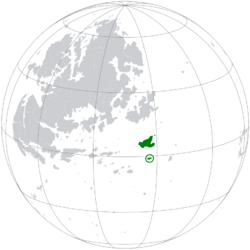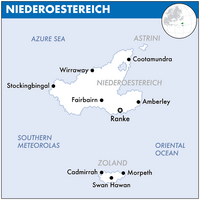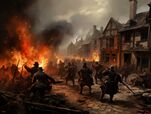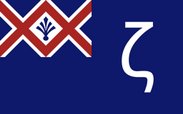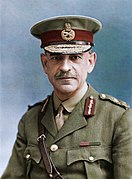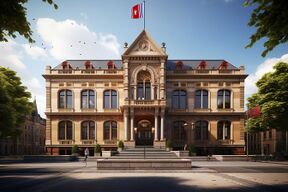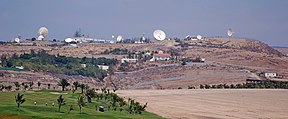Niederoestereich
National Comrades of Niederoestereich | |
|---|---|
| Motto: Communitas, Identitas, Stabilitas (Community, Identity, Stability) | |
| Capital | Ranke |
| Official languages | |
| Demonym(s) |
|
| Government | Unitary council republic |
| John Monash | |
• Premier | Maputi White |
| Legislature |
|
| Establishment | |
| 500 BCE | |
| 1200s | |
| 1754 | |
| 1901 | |
| Population | |
• 2020 census | 14,906,117 |
| Currency | Reichsmark (NRM) |
| Antipodes | Yeosan |
The National Comrades of Niederoestereich, commonly known as Niederoestereich and sometimes also called the State of Niederoestereich, is a sovereign state in the southeastern region of Europa on Eurth. Niederoestereich maritime shares borders with Orioni to the north, Burkini and Sunset Sea Islands to the east, and Bainbridge Islands to the west. With an estimated population of nearly 15 million as per the 2020 census, the country's vibrant capital is the city of Ranke. Governed as a unitary council republic since 1901, the nation's current Chancellor is John Monash, while the Premier is Maputi White. Niederoestereich's legislative powers are vested in a bicameral parliament, comprising the House of Representatives and the Senate. The country's official currency is the Reichsmark (NRM). Niederoestereich's antipodal point is located in Yeosan. The nation maintains strong ties with its neighbouring, countries and is a founding member of the Entente of Oriental States in 2006.
Etymology
The name “Niederoestereich” originates from Old Buranic, a language of the Buran people, an ethnic group known for their seafaring skills. The term “Niederoestereich” is a composite of two words, “nieder” and “oesten”, translating to “lower” or “southern” and “eastern”, respectively. The name essentially means the “lower east” or “southeast”, which aptly describes the relative geographical location of the country as seen from Burania, so in the southeastern part of Europa.
Historical records suggest that the name “Niederoestereich” was first documented around the 1200s. The Buran sailors, renowned for their seafaring skills, were believed to have coined this term when they first navigated to these tropical islands. The Buran were engaged in explorations across Europa, and their naming conventions usually drew heavily from geographical features or location markers, which is evident in the case of Niederoestereich.
Niederoestereich is a pars pro toto, where the largest island's name is used to represent the entire country. In the Oharic language, another major linguistic group on the island, the name for the country is “Astrini”, which comes from the northernmost islands that's closest to Orioni. The exact origins and meaning of this term remain a subject of academic debate. However, it is believed that it might be related to either the Oharic word “Astra” (Anglish: weapon) or “Astär” (Anglish: star), but with deeper mythological roots. And “Ini” is a common Oharic suffix used to form feminine nouns. Etymologists have proposed a reconstructed Oharic mythology where "Astrini” refers not just to the land, but to a class of female warriors said to protect the islands, wielding weapons forged from fallen stars. This could be interpreted as a reference to the island's heavenly beauty and protective strength, or a nod to the vital role celestial navigation played in discovering the island.
While the country is known officially as the ‘National Comrades of Niederoestereich’, and colloquially as Niederoestereich, the name Astrini is still in use among the Orinese minority within the nation. It serves as a symbol to the nation's rich linguistic history and cultural diversity. The dual names for the country, each with a distinct linguistic origin, provide a fascinating insight into the convergence of cultures and languages that have shaped Niederoestereich's history and identity.
Geography
Niederoestereich is a tropical country located in the southeastern region of Europa on Eurth. It is part of the Meteorolan archipelago, at the edge of the enormous Oriental Ocean. The country is made up of three main islands: Astrini, Niederoestereich, and Zoland. Given its location at the eastern end of the Meteorolan islands chain, Niederoestereich has important geographical and strategic significance. Neighbouring countries include Orioni to the north, Burkini and Sunset Sea Islands to the east, and Bainbridge Islands to the west. Niederoestereich's location also influences its economic activities, with fishing and tourism particularly significant in coastal areas. Moreover, the diverse landscapes across the three islands provide for various agricultural activities, contributing to the country's food security and export income.
The country's landscape is immensely varied. The coastal areas are dominated by long, sandy beaches, while inland regions present a mix of tropical rainforests, rolling hills, and fertile plains. The northwest region of the country gives way to the towering Dashtoparan Mountain Range, which is renowned for its rich biodiversity and breathtaking vistas. Numerous rivers criss-cross the land, providing vital freshwater resources for both population centres and agriculture. Niederoestereich's climate is predominantly tropical oceanic, marked by year-round high temperatures, ample sunshine, and frequent rainfall. The trade winds lend a moderating influence, providing relief from the intense heat and distributing rainfall evenly throughout the year. Despite the country's tropical climate and rich natural resources, preservation of the environment is a significant priority in Niederoestereich. The country has numerous national parks and protected areas aimed at conserving its unique flora and fauna, and efforts are continually made to promote sustainable practices in agriculture, industry, and urban development.
The island is a hotspot of biodiversity.
Coconut crabs are protected in Niederoestereich.
Sharks are an endangered species.
Islands
The northernmost island, Astrini, is the smallest of the three. Despite its size, Astrini is notable for its lush, vibrant rainforests, and unique biodiversity. Its coastal regions are characterised by white sandy beaches and coral reefs that are home to a wide variety of marine life, making it a popular spot for diving and ecotourism. The interior of Astrini is hilly with many small, fast-flowing rivers and waterfalls.
The largest and central island, also named Niederoestereich, is the economic and political hub of the country, housing the capital city, Ranke. This island features a diverse landscape that includes mountain ranges, rivers, vast rainforests, and extensive coastal plains. The western coast of the island is particularly known for its beautiful beaches, while the eastern coast is home to impressive cliffs and rugged terrains. The highest point in the country is Mount Kaelen, located on this island, reaching an elevation of 2,981 metres (9,780 ft) above sea level. The island of Niederoestereich is also renowned for its biodiversity, with several national parks and protected areas established to conserve its unique flora and fauna.
Zoland, the southernmost and second-smallest island, has a diverse landscape with an interior dominated by mountains and forests, while its coasts are marked by stunning beaches and large mangrove forests. Zoland is also noted for its vibrant cultural heritage, with numerous indigenous communities maintaining traditional ways of life.
Each of the three islands boasts distinct geographical features and ecosystems, which contribute to the country's rich biodiversity. Niederoestereich's climate is predominantly tropical oceanic, characterised by high temperatures, substantial rainfall, and trade winds that moderate the climate.
States
Niederoestereich is divided into four states, each boasting distinctive geographical and cultural features. From north to south, these states are: Astrini, Hildaleith (northwest), Hardradsholm (southeast), Zoland.
Cities
The capital city, Ranke, is located on the southeastern coast and is a bustling hub of political, economic, and cultural activity. Other significant cities include Wirraway, known for its major trading port and shipyards, and Amberley, a leading centre of education and technology.
Largest populated areas in Niederoestereich
2021 census | |||||||||
|---|---|---|---|---|---|---|---|---|---|
| Rank | State | Pop. | |||||||
 Ranke  Wirraway |
1 | Ranke | Hardradsholm | 2,983,207 |  Amberley  Morpeth | ||||
| 2 | Wirraway | Hardradsholm | 2,822,352 | ||||||
| 3 | Amberley | Hardradsholm | 1,457,031 | ||||||
| 4 | Morpeth | Zoland | 1,243,377 | ||||||
| 5 | Cootamundra | Hildaleith | 795,402 | ||||||
| 6 | Swan Hawan | Zoland | 400,807 | ||||||
| 7 | Wollondilly | Hildaleith | 289,199 | ||||||
| 8 | Tamwick | Hardradsholm | 273,520 | ||||||
| 9 | Gunnedah | Hildaleith | 201,705 | ||||||
| 10 | Narrandera | Astrini | 173,487 | ||||||
History
Prehistory
Niederoestereich, an island replete with historical intricacies, traces its earliest known inhabitants to approximately 80,000 BCE. The earliest settlers, Azano-Marenesian peoples recognised as the Meteorolan settlers, voyaged along the archipelago to establish themselves on the island. Their enduring presence spanned thousands of years, during which they evolved culturally and socially, leaving behind a lasting legacy evident in remnants of their settlements and elaborate stone tools scattered across the island.
One of the most notable migrations to Niederoestereich occurred when the Proto-Marenesians, speakers of the Ayana and Pishatja language isolates, ventured into the region. Their initial settlements predominantly dotted the Meteorolas, marking the beginning of what would be a millennia-long habitation of the island. These Proto-Marenesian expeditions to Niederoestereich are significant, not merely for their attestation to the advanced seafaring skills of the settlers, but also for setting the groundwork for the eventual emergence of the Chulo Empire. Over time, as these settlers adapted to their new environment, they sowed the seeds of a unique and multifaceted culture that would, in the millennia to come, shape the identity and destiny of Niederoestereich.
Chulese period
From the 5th century BCE to the 2nd century CE, Niederoestereich, then a part of the Chulo Empire, underwent significant geopolitical transformations. The Chulo Empire, rooted in the Meteorolan archipelago, was a powerful thalassocracy that extended its dominance over parts of South Europa, including Niederoestereich. With the island positioned as an essential outpost in the vast Chulese maritime network, it played an instrumental role in the Empire's trade and naval defence. The Chulo Empire's earliest documented mentions date back to the 5th century BCE, with inscriptions alluding to their establishment in regions now known as Ayubi, Damak Var, and Bainbridge Islands. Their maritime prowess enabled them to foster trade ties as far as Azanian and Oriental Europa. Historical records from neighbouring Memopotamia referred to the Chulo as Al-Cahuete.
Geographically, the Chulo Empire spanned multiple islands in the southern waters off Europa. Its capital, Pa'pi, situated in present-day Damak Var, was renowned for its deepwater port, facilitating the export of valuable resources extracted from the island's heartland. The economy heavily revolved around intra-island trade, supplemented by limited exchanges with the Europan mainland. Niederoestereich, during this period, underwent advanced infrastructural development, with fortified settlements erected, and local artistry thriving, heavily influenced by Chulese culture. The Chulese are credited with being among the first humans to navigate open seas expertly. While their maritime mastery is unparalleled, historical texts hint at an even earlier seafaring civilisation: the Azano-Marenesian peoples. The discovery of the Chulese islands by mainlanders from Memopotamia set off a cascade of events, leading to increased inter-island interactions and cultural exchanges, culminating in a largely homogenised culture across the islands.
The Chulese governance was characterised by a primitive form of representative democracy. An annual 'Council of the Isles' convened to address key issues, predominantly international relations and foreign trade. This Council was led by an individual titled the 'Hurricane.' Though each island retained autonomy in framing its local laws, coalitions often formed within the Council to represent diverse viewpoints. The height of Chulese power saw a focus on military advancements. Roughly a century post their self-awareness era, termed the 'Awakening,' the islands were swept by a series of wars. Mainland powers, largely indifferent to these conflicts, continued trading, with shipbuilding technology being a notable import to the Chulese islands. Such advancements further solidified the Chulese as the pre-eminent maritime force of their time.
The late Chulese period, culminating around 127 CE, was marked by internal strife. Dissent began in 'The Eye of the Storm' region, under the leadership of Penn Meteo (c. 120–160), a figure who later became emblematic of national unity and resistance. These upheavals, referred to as the 'Winds of Change,' spanned a decade and sought to unify the various island nations. Although Penn Meteo's untimely death prevented the realisation of his unification dream, his efforts weren't entirely in vain. Multiple islands did unite, though age-old disputes over resources and lingering memories of past conflicts prevented a comprehensive unification. Consequently, by the end of the 2nd century CE, the Weathered Islands fragmented into several distinct island states, setting the stage for Niederoestereich's later history and its ultimate identity beyond the Chulese domain.
Part of the Pearl Road
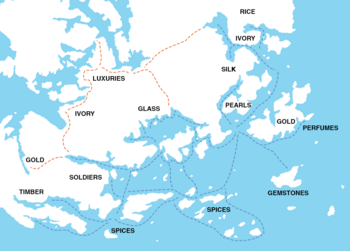
In the aftermath of the Chulo Empire's decline in the 2nd century CE, the island that would later be known as Niederoestereich experienced a transformative period of both geopolitical shifts and sociocultural evolution. Independent kingdoms emerged from the remnants of old Chulese provinces, alongside fortified city-states that blossomed under the influence of an ambitious merchant class. Concurrently, various tribal dominions upheld their deep-rooted traditions amidst this dynamic landscape.
The eastern coastal Kingdom of Lirandor gained prominence during this period, renowned for its rich gemstone mines and the marine expertise of its monarchs. In stark contrast, Brilion, a bustling city-state located to the west, became a beacon of trade and culture, bolstered by its strategic placement along the ancient Pearl Road. The island's heartland, interspersed with fertile plains and rugged highlands, was the realm of the Ghal tribes, known for their martial prowess and periodic trade with the coastal regions. The island's significance on the Pearl Road drew the attention of global maritime powers. The Orioni Empire from the north embarked on several expeditions, lured not only by the island's precious gems but also by the strategic potential of controlling a key maritime junction. Simultaneously, the southern shores became the focal point for the expansionist endeavours of the Republic of Thessolan, which established colonies and trade hubs.
Brilion's ascent to prominence in the 5th century was closely tied to the emergence of Rakashan Tholnaar (c. 404–474), a shrewd gem trader whose enterprise spanned across significant portions of Eurth. Under his stewardship, Brilion underwent infrastructural expansion, with revamped dockyards and fortified walls, cementing its status as a regional powerhouse and enhancing Tholnaar's political influence. As the centuries progressed, the island saw a cultural flourishing. Brilion, enriched by Tholnaar's gem trading ventures, evolved into a centre of learning and commerce. The city attracted a diverse array of intellectuals, craftsmen, and merchants, effectively positioning itself as the island's cultural and economic epicentre. This period also marked a notable Syncretic Movement in the 6th century, where indigenous beliefs seamlessly merged with incoming religious and philosophical thoughts, engendering distinct spiritual practices. Yet, this period of prosperity was not without its challenges. Brilion's ascendancy spurred apprehensions among neighbouring city-states and kingdoms. In efforts to offset Brilion's growing influence, they forged tactical alliances. The Ghal tribes, traditionally reticent in their interactions with coastal civilisations, established confederacies to safeguard their territories and bolster their standing in regional trade negotiations.
By the 8th century, the southern port city of Yssria, under the astute governance of Lysandra Tarin, began to present itself as a formidable rival to Brilion. Yssria's burgeoning influence was partly attributed to its alliance with Thessolan, creating a new axis of power that reshaped regional geopolitics. Intermittent confrontations marked the subsequent centuries. The 9th and 10th centuries witnessed escalating tensions between Lirandor and Yssria, with Brilion frequently mediating to de-escalate hostilities. A significant diplomatic achievement of this era was the Forty Years' Truce, orchestrated by Brilion in the mid-10th century, which sought to establish a transient peace and led to the foundation of the inaugural Trade Council.
However, the respite was short-lived. The dawn of the 11th century saw an intensified engagement of external actors, particularly the maritime dominion of Orioni and the Republic of Thessolan. Their interventions, both covert and overt, exacerbated the island's inherent frictions, leading to the Prelude Wars (c. 1070-1125). This tumultuous backdrop eventually paved the way for the island's involvement in the seminal Orinese Civil War in the 13th century, a conflict that would indelibly redefine its historical trajectory.
Buran period

After the Orinese Civil War, Buranian mercenaries under Commander Hardrada Sigurdsson (c. 1150–1205) were granted Niederoestereich as a reward. Initially, the Buranians faced resistance from native tribes and clans, but with superior weapons and tactics, they managed to establish dominance. Sigurdsson, appreciating the strategic importance of the island, fortified the coasts and built a robust naval fleet. The island's isolation and defensibility made it a prime location for a strategic outpost. Adventurers and indentured serfs from the Buran homeland came to Niederoestereich. This provided the island with a labour force that was employed in agriculture, mining, and infrastructural development. Einar Hardradason (c. 1180–1235), taking over in 1256, continued the policies of his father. However, he was more ambitious in terms of territorial expansion and administration. Through strategic alliances and military campaigns, he extended Buranian control over the entire island. Hardradason also established the foundation of several dynastic houses, which would play pivotal roles in the island's politics and governance in the ensuing centuries.

Using its strategic position, Niederoestereich became a significant maritime hub. Buranian shipbuilders, utilising the island's timber, began constructing larger and more sea-worthy vessels, which embarked on voyages of trade and discovery. As trade flourished, Niederoestereich experienced an influx of ideas, technologies, and people from diverse regions. This cultural synthesis led to a local renaissance. Art, literature, and science thrived, and Niederoestereichian scholars made significant contributions in various fields. The powerful houses established by Einar Hardradason began to vie for control. House Albricht dominated the mountainous regions, gaining prominence for their mining operations and the esteemed Albricht knights. In contrast, House Thalberg, situated along the coastlines, built its reputation on naval expertise and trade. The fertile central plains were under the control of House Van der Oest, turning them into the island's primary agricultural hub. Meanwhile, House Grimvald, situated in the forested southern territories, excelled in timber and craftwork. However, as the years progressed, these houses, driven by their ambitions, found themselves embroiled in a series of conflicts, leading to numerous intrigues, assassinations, and shifts in power. Amid this instability, some native Niederoestereichian clans saw an opportunity to regain their lost territories. Yet, among these shifting sands of power, House Löwenburg rose to prominence. By the mid-15th century, through strategic alliances, marriages, and military campaigns, the Löwenburgs became the dominant force in Niederoestereich. Their leadership brought about a period of relative peace and stability for the island, with a careful balance maintained between the various factions and a focus on the well-being of the general populace.
The 16th century was a golden age for Niederoestereich. The Löwenburgs, despite their authoritarian rule, were patrons of the arts and sciences. The island's economy, boosted by trade and agriculture, was among the region's most vibrant. By the 17th century, emerging colonial powers started eyeing Niederoestereich for its strategic and economic importance. The Löwenburgs had to fend off multiple invasion attempts. Internally, corruption, and complacency began to erode the administrative machinery. The 18th century was marked by a slow decline in Löwenburg power. Repeated crop failures, economic downturns, and external pressures weakened the dynasty. By the mid-century, the Löwenburgs were heavily dependent on mercenaries and foreign alliances. When the last Duke Friedrich Löwenburg (1691–1754) died without an heir, this marked the end of this once-mighty dynasty and paved the way for Niederoestereich's return under Orinese control.
Orinese period
The Löwenburgs were the last of the great Niederoestereichian dynasties that had ruled the archipelago for centuries. Duke Friedrich Löwenburg (c. 1691–1754), the last reigning monarch from the Löwenburg line, was known for his lavish lifestyle and weak governance, often being criticised for his detachment from the needs of the common people. His sudden death in 1754 without a direct heir caused a significant power vacuum. The lack of an heir triggered an obscure clause in the treaty which had gifted the islands to the Buran mercenaries, and Niederoestereich reverted to Orinese control, essentially becoming an outpost of its colonial empire. The instability was seized upon by the Orinese, who had been long eyeing the strategically located islands. Within months, Orinese naval forces anchored at the ports, and Niederoestereich was soon assimilated as an important outpost in their burgeoning colonial empire. The Niederoestereichian nobility was split: while some viewed the Orinese as liberators from the Löwenburg's ineffective rule, others saw them as invaders trampling on their sovereignty.
Following the demise of Duke Friedrich Löwenburg in 1754, Niederoestereich underwent a significant transformation. The initial years were marked by political instability and power struggles among the Niederoestereichian nobility. The Orinese, exploiting this internal discord, gradually entrenched their administrative and military presence. With the consolidation of Orinese rule came significant economic and societal shifts. The Orinese introduced new crops and advanced agricultural techniques, leading to a shift in trade patterns. The main ports of Niederoestereich became vital nodes in the Orinese trade network, connecting to far-off colonies and the Orinese mainland. This period also saw an influx of Orinese settlers, businessmen, and bureaucrats, leading to a cultural amalgamation in urban areas. The Orinese brought with them new religious practices and attempted to propagate their beliefs, leading to occasional tensions with the native Niederoestereichian populace, who were deeply rooted in their own spiritual traditions. In urban centres, new architectural styles, inspired by Orinese designs, started to emerge. This juxtaposition of old and new often led to cultural friction. As the 18th century neared its close, covert resistance groups began to emerge, fuelled by stories of Niederoestereich's glorious past and discontent with Orinese dominance.
In 1801, the country witnessed a sectarian uprising against the Orinese rulership, led by the charismatic rebel leader Anteo Zorzi (1762–1801). Zorzi, a native Niederoestereichian of notable lineage, had studied in Orinese academies and was initially considered a bridge between the two cultures. However, witnessing the plight of his people under colonial rule, he became disillusioned. Using his charisma and profound understanding of both Niederoestereichian and Orinese strategies, Zorzi began to organise a broad coalition of dissatisfied nobles, peasants, and scholars. In the spring of 1801, they launched a surprise attack on Orinese administrative centres. Despite initial successes, the rebellion faced overwhelming Orinese military strength and was quickly suppressed. Zorzi was captured and executed, but his martyrdom became a symbol of resistance. Songs, stories, and plays recounting his bravery spread like wildfire across the islands, ensuring that his legacy would long outlive him.
Following the suppression of Zorzi's uprising in 1801, the Orinese administration took measures to tighten its grip on Niederoestereich. There was a clampdown on dissidents, with many being imprisoned or executed. Fortifications were strengthened, and an increased number of Orinese troops were stationed across the islands. The Orinese rulers, aiming to extract more wealth from their colony, initiated extensive infrastructural projects. Roads, ports, and even railways were built, leading to the expansion of trade and the onset of industrialisation in Niederoestereich. This brought about economic opportunities but also increased the divide between the wealthy elites and the working class. The mid-19th century in Niederoestereich was marked by the rise of intellectualism. Universities, many funded by Orinese patrons, became hotbeds of new ideas, including socialism. The literature of this era, reflecting the societal changes and tensions, often carried veiled critiques of Orinese rule.
As the years passed, the memory of Zorzi's uprising mingled with growing discontent and the rise of new ideologies. By the mid-19th century, socialism began to take root in Niederoestereich, particularly among urban workers and intellectuals. The Slazyu, a clandestine socialist organisation, began covert operations aiming to overthrow the Orinese regime and establish a socialist state. In 1865, they orchestrated a daring attempt to take control of the Royal Palace in Ranke. Though meticulously planned, this Slazyu Revolt (1865) was betrayed from within. Loyalist forces, led by the shrewd General Johannes Schwertfeger (1812–1869), swiftly responded, resulting in a bloody confrontation at the palace gates. The rebellion was crushed, and the leading figures of the Slazyu were captured, tried, and subsequently exiled to distant Orinese colonies. However, their audacious attempt only further stoked the fires of independence, setting the stage for more organised movements in the decades to follow.
Independence
As the 19th century dawned, the island of Niederoestereich was a cauldron of simmering discontent. The roots of this resentment lay deep in the socio-political landscape of the island, primarily due to the heavy-handed rule of the Orinese-Buran elites. These foreign overlords, while bringing technological advancements and modernity, also perpetuated systems that marginalised the native Niederoestereichians, exploiting both their resources and labour. The aura of exploitation became palpable, and the winds of nationalism began to stir. Throughout the 1890s, various local and regional movements emerged. These were not isolated pockets of resistance, but rather a collective uprising of the Niederoestereichian spirit against what was perceived as foreign dominance and disdain. The people sought to reclaim not just their land but also their heritage, their voice, and their very identity.
Karl Hohenberg (1843–1908) emerged as a beacon of this awakening. A charismatic leader with an indomitable spirit, Hohenberg unified the disparate strands of the nationalistic fervour, giving them direction and purpose. It was under his leadership that secret meetings were held, plans were hatched, and the foundations of a new Niederoestereich were laid. As the decade drew to a close, the crescendo of these uprisings became impossible to ignore or suppress. Recognising the magnitude of the nationalist movement and sensing the pulse of the nation, Rosenberg orchestrated a massive assembly in 1901. It was at this historic gathering that the Declaration of Independence was proclaimed, sending waves of joy, relief, and anticipation throughout Niederoestereich. The island was no longer under the shadow of Orioni; it had found its voice and its identity. Karl Hohenberg, the architect of this new dawn, was elected as the first Chancellor of Niederoestereich, heralding a new era of self-rule and pride. However, the road to true independence was not without its challenges. The fledgling nation, while free from foreign rule, still bore the imprints of years of external influence. There was a palpable fear that the unique cultural and social fabric of Niederoestereich might get diluted or lost in this new age of globalisation.
It was in this backdrop that Chancellor Reinhold Bürkl (1873–1952), in the 1920s, introduced the “White Niederoestereich Policy.” This was a bold and controversial step aimed at preserving the distinct identity of Niederoestereich. By controlling foreign influence and ensuring that the island's culture, traditions, and ethos remained at the forefront, Bürkl envisioned a nation that was modern yet deeply rooted in its history. The policy, while criticised by some quarters, underscored the commitment of Niederoestereich's leaders to safeguard their newly-won independence and the essence of their homeland. Thus, the early 20th century marked not only the political emancipation of Niederoestereich, but also its cultural and social resurgence. The island had embarked on a journey of self-discovery, reclamation, and pride, shaping its destiny on its terms.
Contemporary era
Following its tumultuous period of independence and the subsequent cultural resurgence, Niederoestereich entered a new epoch by the mid-20th century. As the world around them grappled with the after-effects of global wars and ideological shifts, Niederoestereich found itself at a crossroads, seeking its place in the rapidly changing international landscape.
The 1940s saw the rise of Chancellor Konrad Alden (1898–1967), a visionary leader who recognised the potential of embracing democratic governance.[1] Under Aden's guidance, Niederoestereich embarked on a transformative journey from a unitary council republic to a robust democracy with right-wing inclinations. This move turned out to be profound for Niederoestereich, ushering in an era of increased political transparency, popular participation, and a steadfast commitment to civil liberties. The country's political fabric began to diversify, leading to the establishment of various parties and the proliferation of a vibrant press.
However, as the 20th century wore on, the world outside continued to change. The latter half of the century saw the ascent of both nationalism and communist ideologies in various parts of the globe. The effects of these movements weren't lost on Niederoestereich. The youth, intellectuals, and a considerable portion of the working class began to harbour feelings of disillusionment with the current system, echoing a yearning for change and more equitable distribution of resources.
By the dawn of the 21st century, the undercurrents of this discontent reached a boiling point. In 2005, a coalition of the Army, workers, and the middle class, orchestrated a swift and largely bloodless revolution. Spearheaded by John Monash (born 1963), a charismatic leader with deep ties to both nationalist and communist ideologies, the revolution marked a turning point in Niederoestereich's history. In the aftermath, the country underwent significant changes. Adopting a new name, “National Comrades of Niederoestereich,” it sought to epitomise the fusion of nationalist pride and the principles of communism.[1] A new political structure was established, balancing centralised control with grassroots involvement. The economy underwent reforms aimed at state ownership of critical sectors, while simultaneously encouraging local entrepreneurship and cooperative models.
The post-revolution years saw extensive efforts to solidify the new order. Education reforms emphasise the country's history, achievements, and the principles of the revolution. National projects aimed at infrastructure, healthcare, and social welfare were initiated, leading to a marked improvement in the quality of life for many Niederoestereichians. Today, the National Comrades of Niederoestereich stands as a unique blend of ideologies, striving to achieve national pride and unity while ensuring social justice and equity for its citizens. The journey from a recently independent nation to its current stature has been filled with challenges and triumphs, and the spirit of Niederoestereich remains indomitable as it navigates the intricacies of the modern world.
Politics
Government
Niederoestereich is a unitary council republic, with a government responsible for making and enforcing the laws that govern the country. This government is divided into three branches – the executive, legislative, and judicial – which work together to ensure the smooth functioning of the government and the protection of the rights and freedoms of the people of Niederoestereich.
The executive branch is led by the Chancellor, who serves as the head of state, and the Premier, who is the head of government. The current Chancellor is John Monash, known for his fiery temper and unsuccessful advocacy for conscription at the start of the 2005 revolution.[1] The current Premier is Maputi White (born 1978).
The legislative branch is bicameral, comprising the House of Representatives and the Senate, both elected by the people of Niederoestereich. The House of Representatives is responsible for introducing and passing laws. Members of the House are elected by the populace and represent the people's interests. The Senate acts as a review chamber and advisory body, refining the laws passed by the House of Representatives. Both houses meet in the Unity Hall of Niederoestereich in Ranke.
The judicial branch is independent of the other two. It is responsible for interpreting and enforcing the laws of the country through a system of courts. The highest judicial authority is the Supreme Court, which ensures that laws and government actions comply with the constitution and are enforced fairly.
Cabinet
The Cabinet of Niederoestereich comprises the Chancellor, the Premier, and senior ministers, each of whom leads a governmental department. The Cabinet's main roles include policy formulation, legislative proposal, and critical decision-making regarding the country's governance.
Chancellor John Monash, the country's Head of State, and Premier Maputi White, the Head of Government, lead the Cabinet. In Niederoestereich, the order of succession for the Cabinet typically follows the roles' importance and authority within the government. In case the Chancellor and Premier are both unable to serve, the below order of succession determines who will assume the position of Acting Chancellor until a new Chancellor can be formally appointed. The list, ordered by precedence and determining the line of succession, is as follows:
- Treasurer: Hon. Charles Anderson – Responsible for the country's economic and financial matters.
- Minister for Foreign Affairs: Hon. Joseph Partridge – Responsible for the country's international relations and diplomatic affairs.
- Minister for Defence: Hon. Harold Throssell – Responsible for the defence and security of the country.
- Attorney-General: Hon. Richard Keliher — The chief law officer responsible for the country's legal affairs.
- Minister for Finance and Administration: Hon. Jacob Maxwell – Responsible for financial management, budget, and administrative operations of the government.
- Minister for Trade: Hon. Arnold Blackburn – Responsible for promoting trade and managing trade relations.
- Minister for Health and Ageing: Hon. Rebecca Simpson – Responsible for the nation's health system and policies relating to aged care.
- Minister for Immigration and Multicultural Affairs: Hon. Jennifer Dwyer – Responsible for immigration policies and managing multicultural affairs.
- Minister for the Environment and Heritage: Hon. Caroline Jeffries – Responsible for environmental policies and heritage conservation.
- Minister for Education, Science, and Training: Hon. William Dunstan – Responsible for the country's education system, science and research policies, and vocational training.
- Minister for Transport and Regional Services: Hon. Henry Murray – Responsible for the country's transport system and regional development.
- Minister for Industry, Tourism, and Resources: Hon. Andrew Gurney – Responsible for the country's industries, tourism sector, and resource management.
- Minister for Communications, Information Technology and the Arts: Hon. Amelia Hall – Responsible for the country's communication infrastructure, IT policies, and arts and culture.
- Minister for Agriculture, Fisheries and Forestry: Hon. James Woods – Responsible for the agriculture sector, fisheries, and forest management.
- Minister for Family and Community Services: Hon. Christopher Pope – Responsible for policies related to families, social services, and community development.
- Minister for Employment and Workplace Relations: Hon. Robert Grieve – Responsible for labour policies, employment, and workplace relations.
Additional key positions in the government are:
- General of Combined Forces: General James Hennessy
- Head of Niederoestereichian Secret Intelligence Organisation (NSIO): Major David Zhukov
The Cabinet convenes regularly to discuss and decide on important national issues. The individual ministers are responsible for the operation and administration of their respective departments and the implementation of government policy within their jurisdiction. The composition of the Cabinet reflects the diverse sectors of governance necessary for the effective running of the country, ranging from social services to security.
Policy
Niederoestereich's policy framework is based on the principles of social justice, economic stability, and environmental sustainability. The government is committed to providing quality healthcare, education, and social services to its citizens. Economic policies are aimed at fostering innovation, job creation, and sustainable development. Environmental policies focus on conserving the country's biodiversity, promoting renewable energy, and addressing climate change.
Military
The Niederoestereichian Defence Force (NDF) is responsible for the defence of Niederoestereich. Most of the military budget is directed towards the army, then navy, air force, and finally space projects. Niederoestereich's main attribute is its army, although only made up of volunteers with a small professional army. Her army infantry is mainly used as shock troops, which enjoys good morale in most situations. There are armoured cavalry regiments, although none professional, they still rival if not better their counterparts. Its naval is relatively small, since before 1900; its former motherland had taken care of defence. Niederoestereichian Navy is mainly late 20th century frigates, destroyers, minelayers and corvettes, no dreadnoughts or heavy cruisers. Niederoestereichian Air Force is rather limited. In 2005, Niederoestereich launched it first space vehicle.[1]
The command structure of the NDF is straightforward: the Head of State is the supreme commander and decides where the forces are deployed, while the General of the Combined Forces is promoted from one of the three leaders of each respective defence branch. These positions are held by respectively Chancellor John Monash and General James Hennessy from the Niederoestereichian Army. Although the Niederoestereichian military may not contain the latest and greatest technology, the training programmes and officer training greatly enhance available resources. Pure; basic soldiering is taught without having to rely on technology. In war zones, all ranks attend briefings, including cooks, as so if the officers are taken out, the force can carry on sufficiently.
One of the key formations in the NDF is the ANZAC Army Corps. This Corps is a tri-island military collaboration comprising units from the three main islands of Niederoestereich: Astrini, Niederoestereich and Zoland. The Astrinese Division, stationed on the northern island of Astrini, specialises in amphibious operations and coastal defence, taking advantage of Astrini's proximity to maritime trade routes. The Niederoestereichian Division, based in the capital city of Ranke, is the largest of the three divisions. It boasts robust mechanised and armoured capabilities, being the primary rapid reaction force in times of crisis. The Zolander Division is known for its advanced reconnaissance capabilities and expertise in jungle warfare, capitalising on the unique landscape of the Zoland island.
Foreign relations
As a member of the Entente of Oriental States, Civil Administration of Oriental States and the Group of Island Nations, Niederoestereich actively participates in international diplomatic affairs. The country maintains cordial relations with Orioni, its former coloniser, and has established diplomatic ties with numerous nations around the wurld. Niederoestereich pursues a policy of peace, cooperation, and mutual respect in its foreign relations. It is committed to multilateralism and upholds international law in the pursuit of global peace and stability.
Economy

Niederoestereich boasts a well-developed and diversified economy, characterised by robust industrial sectors, dynamic service industries, and an increasingly significant knowledge economy. The government follows a mixed economic policy, combining market-oriented economic reforms with strategic state interventions to promote economic stability and growth.
The industrial sector, particularly the automobile and machinery manufacturing industries, forms a significant part of the Niederoestereichian economy. Government policy encourages technological innovation, productivity enhancements, and sustainable manufacturing practices. The service sector, including financial services, healthcare, and information technology, contributes significantly to the GDP and employment.
The country has also begun to focus on building its knowledge economy, emphasising sectors such as biotechnology, renewable energy, and digital services. Government initiatives support research and development, innovation, and entrepreneurship in these fields, fostering the growth of high-tech startups and attracting foreign direct investment.
Currency
The country's official currency is the Reichsmark (NRM).
Trade and transportation
Niederoestereich maintains a high level of foreign trade, being strategically located in Southeast Europa, with easy access to major markets in Orioni, the Sunset Sea Islands, and the Bainbridge Islands. The country's trade policy focuses on liberalisation, fostering strong bilateral relations, and promoting regional economic integration.
Historically, Niederoestereich has had strong trade relationships with Orioni and its former Buranian homeland, with significant imports and exports flowing between these nations. The government actively seeks to diversify trade partnerships and has signed several free trade agreements to enhance economic ties with other countries.
Niederoestereich has an extensive and well-developed transportation network, which includes road, rail, air, and sea transport. The country has a vast network of highways and motorways, which connect all major cities and regions. Rail transport is also widespread and includes both passenger and freight services. Niederoestereich's airports offer domestic and international flights, and its seaports handle large volumes of cargo and passenger traffic.
Tourism

Tourism forms an important part of Niederoestereich's economy. The government encourages sustainable tourism that respects and preserves the country's natural and cultural heritage. With a tropical oceanic climate, the country offers stunning natural beauty, ranging from pristine beaches and lush rainforests to rugged mountains and stunning coral reefs.
The capital city, Ranke, is known for its vibrant culture, historical landmarks, and culinary scene. The port city of Wirraway attracts tourists with its bustling markets, beautiful seaside promenades, and maritime heritage. Niederoestereich's national parks offer ecotourism opportunities, allowing visitors to explore the country's unique flora and fauna.
Moreover, Niederoestereich has become a popular destination for adventure tourism, with activities such as surfing, scuba diving, rock climbing, and hiking drawing tourists from around the wurld. The government is actively promoting Niederoestereich as a premier ecotourism and adventure tourism destination.
Media
Niederoestereich has a vibrant and diverse media landscape, which includes newspapers, television, radio, and digital media. The country's media is known for its robustness, independence, and commitment to the principles of freedom of speech and the press. The public broadcaster, Niederoestereichian Broadcasting Corporation (NBC), is funded by the government but operates independently. It provides a wide range of programming, including news, current affairs, sports, entertainment, and children's programming.
Demographics
Niederoestereich has a relatively high life expectancy, according to data from the Assembled Nations. The country has a significant immigrant population, with many people moving to Niederoestereich for work, study, or family reasons. It also has an Indigenous population with a long and rich history on the land. Niederoestereich has a high level of urbanisation, with most of the population living in cities and towns. The largest cities in the country are Ranke, Wirraway, and Amberley. Niederoestereichians have historically viewed themselves as an egalitarian society, with a distrust of the rich and powerful. This belief continues in the form of the “tall poppy syndrome,” where successful individuals or organisations are criticised or resented for their success. This cultural phenomenon is common in many societies and is considered as a way to level the playing field and prevent social inequality. Overall, it is a diverse country with a rich history and culture, and a strong focus on education and social equality. It is known for its beautiful beaches, tropical rainforests, and welcoming people.
Language
The language combines a mocking disrespect for established authority, particularly if it is pompous or “out of touch” with reality, with a distinctive upside-down sense of humour. For instance, Niederoestereichians take delight in dubbing a tall man “Shorty”, a silent one “Rowdy”, a bald man “Curly”, and a redhead, of course, is “Blue”. Politicians, or “pollies”, be they at the state or federal level, are universally disliked and distrusted.
Religion
Niederoestereich is a secular country with freedom of religion. The major religions in the country are Christianity, Buddhism, and Hinduism. There is also a significant number of people who identify as having no religion. Despite the religious diversity, Niederoestereichians are generally tolerant and respectful of each other's religious beliefs.
Education
Education in Niederoestereich is highly valued and is mandatory for all children aged between six and sixteen years old. The education system is divided into three levels: primary education, secondary education, and tertiary education. Primary education lasts for six years and includes basic skills such as reading, writing, and arithmetic. Secondary education lasts for six years and is divided into lower and upper secondary. Lower secondary education focuses on general education, while upper secondary education focuses on specific areas of study and prepares students for university or vocational training. Tertiary education includes universities and vocational institutions. Niederoestereich's universities are highly ranked internationally and offer a wide range of courses in areas such as humanities, science, and technology.
Healthcare
Niederoestereich has a universal healthcare system, which is funded by taxpayers and managed by the government. All citizens and permanent residents have access to free or subsidised healthcare services, including general practitioner services, hospital care, and prescription medications. The healthcare system in Niederoestereich is known for its high quality of care and its emphasis on preventive healthcare.
Culture
The Niederoestereichian culture has historically been a masculine one, forged on the hardship of early settlers, and later on the heroism of the Niederoestereichian soldiers in past conflicts. “Mateship”, or loyal fraternity, has reigned supreme. This also explains why the more aggressive forms of sport enjoyed by all. Niederoestereichians are passionate about sports, and it forms a major part of the country's culture. Cricket is the most popular sport.
Niederoestereichians have traditionally had a strong “underdog” attitude, that is, they will support those who appear to have the lesser hand, so long as Niederoestereich is not involved. This is evident in Niederoestereich's involvement in the Second Tamurin War, supporting the cause of the Imperials. The country shares distant cultural ties with Tamurin, a country which was similarly dominated by a Buranian elite for several centuries.
Niederoestereichians, are relaxed, tolerant, easy-going and yet cling dearly to the fundamental importance of common-sense justice, or to use the classic expression, a “fair go”. It is the land of the long weekend: a country that declares a universal holiday for a horse race, that pioneered the eight-hour working day, that takes pride in never working too hard and yet idolises the “little battler” who sweats away for a small reward. Niederoestereichians respect “hard yakka”; to be “flat out like a lizard drinking” is to be extremely busy, or occasionally the direct opposite. Niederoestereichians are said to make great sportsmen and superb soldiers.
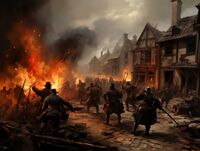
The evocative portrayal of the Slazyu Revolt in 1865 was masterfully rendered by the esteemed Niederoestereichian artist Wilhelm Koenig (1824–1891). Finished in 1872, a mere seven years after the tumultuous event, Koenig's work has since become an emblem of national resilience and a poignant reminder of the struggles endured by the Niederoestereichian people. Beyond its artistic merit, the painting took on a significant symbolic role in subsequent years. As the winds of change blew across Niederoestereich, this painting became a rallying symbol for later independence movements, serving as a reminder of the sacrifices of previous generations and the indomitable spirit of the nation. The passion, chaos, and raw emotion Koenig captured not only commemorated a specific moment in history, but also galvanised future generations in their pursuit of sovereignty.
There are a number of public holidays and festivals, which reflect the country's history, culture, and values. Major holidays include Niederoestereich Day, which commemorates the establishment of the first permanent European settlement in the country, and ANZAC Day, which honours the members of the Astrini, Niederoestereich and Zoland Army Corps (ANZAC) who served and died in all wars, conflicts, and peacekeeping operations. Major festivals include the Niederoestereich Festival, which celebrates the country's arts and culture, and the Niederoestereich International Film Festival, which showcases the best in local and international cinema.
References
- ↑ 1.0 1.1 1.2 1.3 The National Comrades of Niederoestereich (europans.com)

